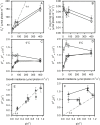Photoacclimation of the polar diatom Chaetoceros neogracilis at low temperature
- PMID: 36125987
- PMCID: PMC9488821
- DOI: 10.1371/journal.pone.0272822
Photoacclimation of the polar diatom Chaetoceros neogracilis at low temperature
Abstract
Polar microalgae face two major challenges: 1- growing at temperatures (-1.7 to 5°C) that limit enzyme kinetics; and 2- surviving and exploiting a wide range of irradiance. The objective of this study is to understand the adaptation of an Arctic diatom to its environment by studying its ability to acclimate to changes in light and temperature. We acclimated the polar diatom Chaetoceros neogracilis to various light levels at two different temperatures and studied its growth and photosynthetic properties using semi-continuous cultures. Rubisco content was high, to compensate for low catalytic rates, but did not change detectably with growth temperature. Contrary to what is observed in temperate species, in C. neogracilis, carbon fixation rate (20 min 14C incorporation) equaled net growth rate (μ) suggesting very low or very rapid (<20 min) re-oxidation of the newly fixed carbon. The comparison of saturation irradiances for electron transport, oxygen net production and carbon fixation revealed alternative electron pathways that could provide energy and reducing power to the cell without consuming organic carbon which is a very limiting product at low temperatures. High protein contents, low re-oxidation of newly fixed carbon and the use of electron pathways alternative to carbon fixation may be important characteristics allowing efficient growth under those extreme environmental conditions.
Conflict of interest statement
The authors have declared that no competing interests exist.
Figures





References
-
- Kropuenske LR, Mills MM, Van Dijken GL, Bailey S, Robinson DH, Welschmeyer NA, et al.. Photophysiology in two major Southern Ocean phytoplankton taxa: Photoprotection in Phaeocystis antarctica and Fragilariopsis cylindrus. 2009;54(4):21. - PubMed
-
- Mills MM, Kropuenske LR, van Dijken GL, Alderkamp A-C, Berg GM, Robinson DH, et al.. Photophysiology in two southern ocean phytoplankton taxa: photosynthesis of Phaeocystis antarctica (Prymnesiophyceae) and Fragilariopsis cylindrus (Bacillariophyceae) under simulated mixed-layer irradiance. J Phycol. 2010;46(6):1114–27.
Publication types
MeSH terms
Substances
LinkOut - more resources
Full Text Sources
Research Materials

